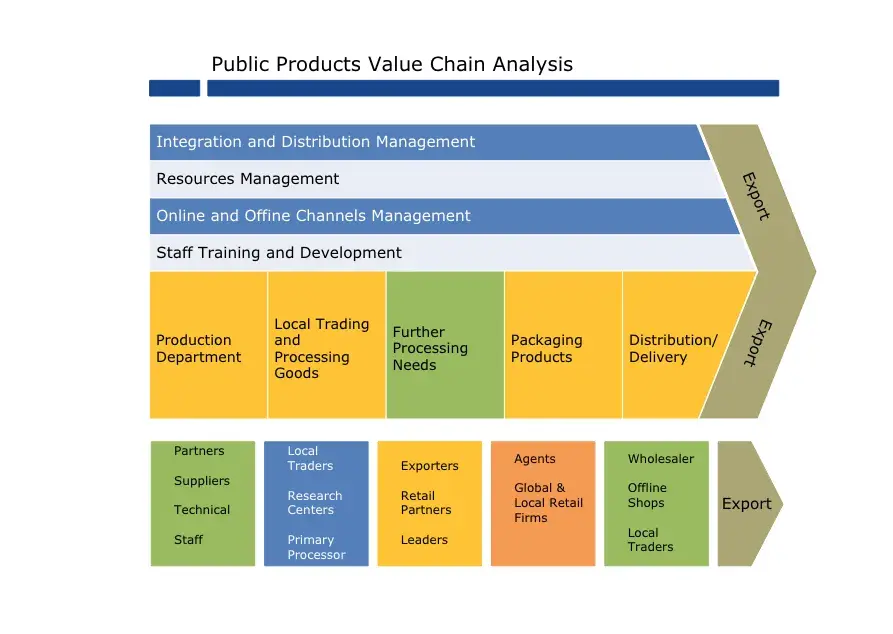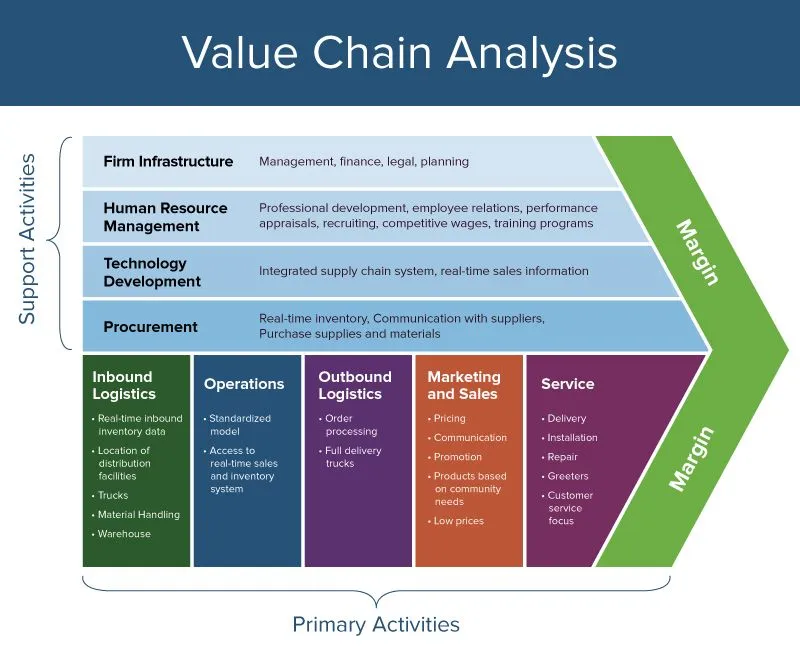Value Chain Analysis: Enhancing Competitive Advantage
In today’s fast-paced business landscape, understanding the intricacies of Value Chain Analysis (VCA) is crucial for organizations seeking to enhance their competitive advantage. This strategic tool not only helps companies identify their strengths and weaknesses but also allows them to optimize operations to deliver greater value to customers.

What is Value Chain Analysis?
Definition of Value Chain Analysis
Value Chain Analysis is a strategic method used to analyze the internal activities of a business. It allows organizations to understand the flow of activities that contribute to the creation of value for customers. By dissecting each step of the production processfrom inbound logistics to outbound logisticsbusinesses can pinpoint areas where they can reduce costs, improve efficiency, and differentiate their offerings.
Historical Context
Developed by Michael Porter in his 1985 book Competitive Advantage, the concept of the value chain revolutionized how businesses analyze their operations. Porter argued that a company’s ability to create value hinges on its understanding of the various activities it undertakes. By analyzing these activities, businesses can leverage their strengths and address weaknesses, thus achieving a sustainable competitive edge.
Components of Value Chain Analysis
Understanding the components of the value chain is essential for any organization aiming to optimize its operations. The value chain comprises two main categories: primary activities and support activities.
Primary Activities
These activities are directly involved in creating and delivering a product or service. They include:
- Inbound Logistics: These are the processes related to receiving, storing, and distributing inputs internally. Efficient inbound logistics ensure that the right materials are available at the right time.
-
Operations: This refers to the processes that transform inputs into the final product. Effective operations management is critical for maintaining product quality and minimizing waste.
-
Outbound Logistics: These activities involve the distribution of the finished product to customers. Streamlined outbound logistics enhance customer satisfaction by ensuring timely delivery.
-
Marketing and Sales: These activities focus on attracting and convincing customers to purchase the product. A robust marketing strategy can significantly increase sales volume and brand loyalty.
-
Service: After the sale, providing excellent service enhances customer satisfaction and fosters loyalty. This includes activities such as customer support, repair services, and warranty management.
Support Activities
Support activities assist the primary activities and help improve their effectiveness. These include:
- Firm Infrastructure: This encompasses the company’s systems of governance, planning, and strategy. A strong infrastructure supports effective decision-making and strategic direction.
-
Human Resource Management: Recruiting, hiring, and training the right talent is crucial for maintaining operational efficiency. HR practices should align with the overall strategy to foster a motivated workforce.
-
Technology Development: This includes research and development (R&D) that improves processes and products. Companies that invest in innovation often achieve a significant competitive advantage.
-
Procurement: This involves sourcing raw materials and negotiating contracts with suppliers. Effective procurement strategies can lead to cost savings and enhanced quality.
Benefits of Value Chain Analysis
Conducting a value chain analysis provides numerous benefits for organizations. Here are some of the key advantages:
Identifying Competitive Advantage
By analyzing the value chain, companies can identify their unique strengths that set them apart from competitors. This understanding enables businesses to leverage these strengths for improved market positioning.
Cost Reduction
Value chain analysis helps organizations pinpoint inefficiencies and redundancies in their processes. By addressing these issues, companies can reduce costs, leading to increased profitability.
Enhanced Customer Satisfaction
Understanding how value is created allows businesses to tailor their offerings to meet customer needs better. This customer-centric approach enhances satisfaction and loyalty, driving repeat business.
Steps to Conduct Value Chain Analysis
Conducting a value chain analysis involves several systematic steps:
Step 1: Identify Activities
Begin by listing all the activities involved in the production and delivery of your product or service. This includes both primary and support activities.
Step 2: Analyze Cost and Value
For each activity identified, assess the costs associated with it and the value it brings to customers. This helps in understanding the profitability of each segment.
Step 3: Identify Linkages
Determine how different activities are linked to one another. Recognizing these interdependencies can highlight opportunities for optimization.
Step 4: Assess Competitive Advantage
Evaluate how your activities compare to those of your competitors. This assessment helps identify areas where you can outperform others in your industry.

Challenges in Value Chain Analysis
While value chain analysis offers numerous benefits, companies may face challenges in its implementation. Data collection can be a significant hurdle, especially for larger organizations with complex operations. Furthermore, translating the insights gained into actionable strategies may require overcoming organizational resistance to change.
For a more detailed exploration of value chain analysis, visit Harvard Business School for insights into best practices and case studies.
Stay tuned for the second half of this article, where we’ll explore real-world case studies and address frequently asked questions about value chain analysis.
Real-World Applications of Value Chain Analysis
Value Chain Analysis (VCA) has been effectively applied across various industries, demonstrating its versatility and utility. Let’s look at some real-world examples to understand how companies leverage this strategic tool to gain a competitive edge.
Case Study: Apple Inc.
Apple is renowned for its innovative products and exceptional customer service. By conducting a thorough value chain analysis, Apple has been able to identify its core competencies, such as design, branding, and customer experience.
- Inbound Logistics: Apple sources high-quality materials from reliable suppliers, ensuring that its products maintain a premium standard.
-
Operations: The company’s production processes are optimized for efficiency, utilizing advanced technology and manufacturing techniques.
-
Outbound Logistics: Apples distribution network is robust, enabling swift and reliable delivery to customers worldwide.
-
Marketing and Sales: Apple invests significantly in marketing to create a strong brand image and generate demand for its products.
-
Service: The company offers excellent after-sales support, fostering customer loyalty and satisfaction.
Through its value chain analysis, Apple can consistently innovate and deliver products that resonate with its customers, ensuring ongoing success.
Case Study: Toyota Motor Corporation
Toyota is another prime example of how value chain analysis can enhance operational efficiency. The company employs the Toyota Production System (TPS), which focuses on eliminating waste and improving productivity.
- Inbound Logistics: Toyota emphasizes strong relationships with suppliers to ensure quality and efficiency in its supply chain.
-
Operations: The implementation of lean manufacturing principles allows Toyota to minimize waste and maximize output.
-
Outbound Logistics: The company has optimized its distribution channels to reduce lead times and improve delivery efficiency.
-
Service: Toyota places great importance on customer feedback, which informs continuous improvement in its processes.
By utilizing value chain analysis, Toyota has established itself as a leader in the automotive industry, known for quality and reliability.
Frequently Asked Questions (FAQs)
What is the purpose of Value Chain Analysis?
Value Chain Analysis aims to help organizations identify their internal activities that create value for customers, enabling them to optimize operations and gain a competitive advantage.
How can I implement Value Chain Analysis in my business?
To implement VCA, follow these steps:
- Identify your activities: List all primary and support activities involved in your operations.
- Analyze cost and value: Assess the costs and value of each activity.
- Identify linkages: Understand how different activities interact with one another.
- Assess competitive advantage: Compare your activities against competitors to identify areas for improvement.
What are the challenges of conducting Value Chain Analysis?
Some common challenges include:
- Data collection: Gathering accurate and comprehensive data can be time-consuming.
- Resistance to change: Employees may be resistant to implementing changes suggested by the analysis.
- Complexity: For larger organizations, understanding the intricacies of each activity can be daunting.
Conclusion
Value Chain Analysis is a powerful tool for organizations aiming to enhance their operational efficiency and competitive advantage. By breaking down activities into primary and support components, businesses can identify strengths and weaknesses, optimize processes, and ultimately deliver greater value to their customers.
Incorporating VCA into your strategic planning not only helps in understanding your business better but also fosters a culture of continuous improvement.
For further insights into how value chains can impact your business strategy, visit Harvard Business School.
Additional Resources
- For a deeper dive into value chain concepts, check out this comprehensive guide on Value Chain Analysis.
- Interested in implementing value chain analysis? This visual overview provides a succinct breakdown of the process.
By understanding and applying the principles of value chain analysis, your organization can navigate the complexities of todays market landscape with agility and insight, ensuring sustainable growth and success.

